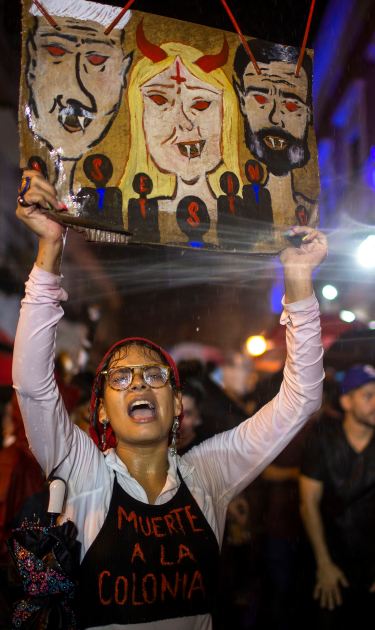On Thursday night, protests calling for the resignation of Puerto Rican Gov. Wanda Vázquez Garced in Old San Juan culminated in violence: Police launched tear gas at the crowd gathered at Calle Fortaleza leading to the governor’s mansion around 11 p.m. Police Commissioner Henry Escalera told Wapa TV that the decision was made after objects were thrown at officials and claimed there were 14 warnings before gasses were used. Protesters allegedly tried to set fire to a Wapa TV van, which had been spray-painted with “embusteros,” or “liars.”
All around the archipelago — and throughout the diaspora — Puerto Ricans are again mobilizing.
The protest began with a 5 p.m. convening at the Capitol Building. Despite the rainy weather, hundreds of vexed Puerto Ricans attended the demonstration. The call was originally announced by workers’ syndicates earlier this week, but it was quickly supported by various unions, movements and resistance groups. An extra push was added with the endorsement of two famous Puerto Ricans: rapper Residente, who spoke at the protest, and Major League Baseball player Yadier Molina, who for days has battled back and forth with Puerto Rican senator and president of the archipelago’s pro-statehood party Thomas Rivera Schatz on social media. Bad Bunny and Ricky Martin have also expressed support.
Throughout the protests, which began in Old San Juan on Monday, multiple guillotines have appeared. Demonstrators rallied around the execution apparatus on Tuesday evening at the corner of Calle Fortaleza and Calle Cristo as well as during Thursday night’s rally. The device complements a new protest chant condemning Vazquez as an “assassin” who “deserves the guillotine.”

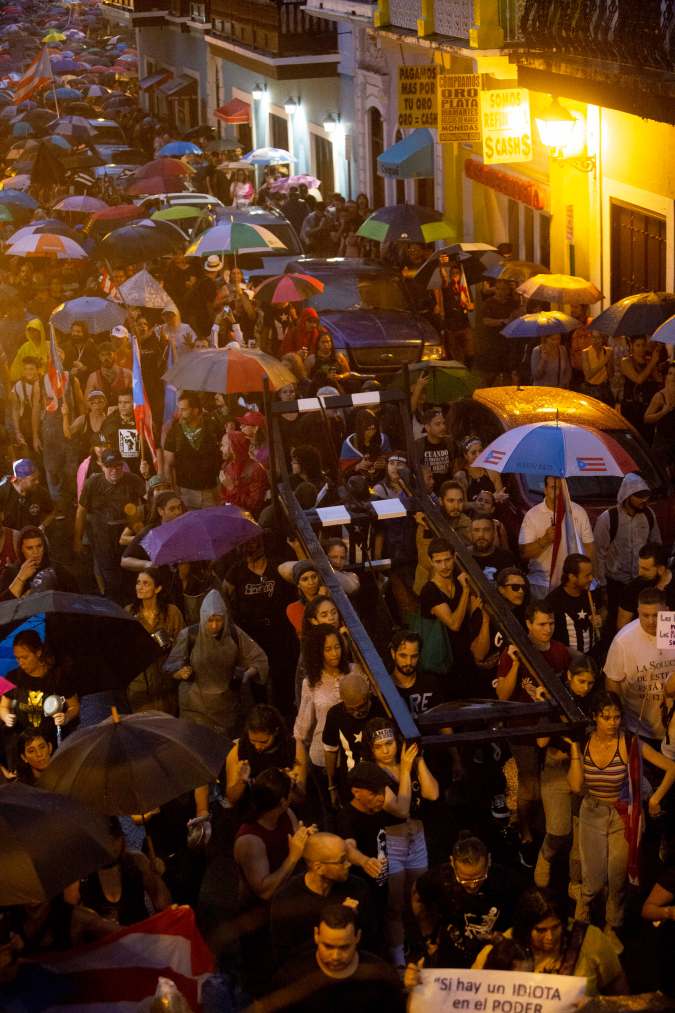
All around the archipelago — and throughout the diaspora — Puerto Ricans are again mobilizing with posters, chants and cacerolas. Like the #RickyRenuncia movement, which ousted former Puerto Rican Gov. Ricardo Rosselló in the summer of 2019, the biggest concentration is in Old San Juan, where daily protesters stomp the same cobblestones of last year’s historic events. Only now they’re calling for the resignation of Rosselló’s successor, Vázquez.
“This is our pueblo. We are the people who get up every day and fight for this country.”
But Puerto Ricans have some other demands, too. Some hold signs indicating they’re protesting on behalf of everyone in the south, where thousands have been displaced into shelters and encampments while earthquakes and aftershocks have almost hourly rattled the region for nearly a full month. Others brandish placards about being fed up with government’s corruption and lies. There are references to the estimated 4,645 people who died as a result of the crisis following Hurricane María, and there is outrage over the discovery last weekend of a warehouse in southern Ponce, a town hit hard by the earthquakes, stocked full of undistributed disaster aid, presumably intended for survivors of the 2017 disaster — several items, like bottled water, bore 2017 expiration dates.
Despite the switch of figures in the crosshairs, these latest protests have mostly picked up where last summer’s campaign left off. It’s another page in the same, very long book about colonialism, corruption and the systemic oppression of a people that has been accumulating chapters of resistance that dates back to the revolts of Indigenous Taínos against Spain in the early 1500s.

Still, something has shifted. Many Puerto Ricans seem angrier than they did last summer. The dissolution of the U.S. Federal Oversight Board, locally called La Junta, was demanded then and is being called for now as well. The removal of the governor, along with other corrupt politicians, is accompanied by calls for their imprisonment.
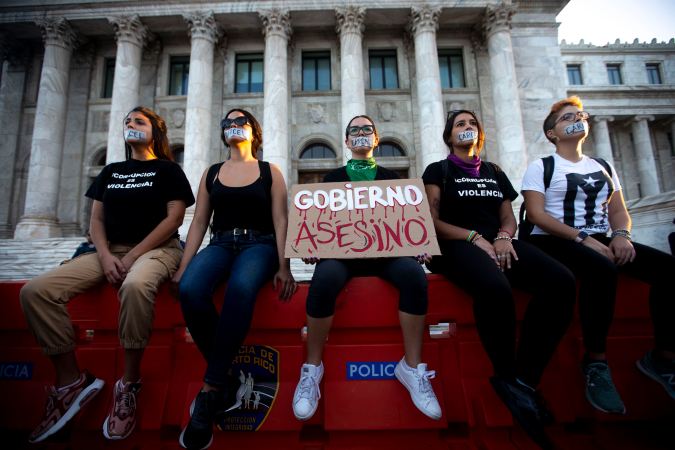
Schatz, who is the president of the Senate, is one official specifically targeted. Last week, referring to the thousands of Puerto Ricans caravaning regularly to the south to help those affected by the earthquakes, he publicly called Puerto Ricans “stupid” for mistrusting the government with relief efforts. There are Puerto Ricans who believe the conservative politician is behind much of Vazquez’s moves, too.
“We have so much evidence [about] the hate this government has for the people.”
Two signs held by protesters on Monday portrayed Schatz and Vazquez painted with Hitler mustaches on Nazi swastikas. More than a few activists expressed preferring to see these politicians’ heads on sticks rather than sitting behind bars.
Natalie Droz, a resident of Bayamón, leaned against the police-guarded barricades situated to block passage to La Fortaleza, the governor’s mansion, on Monday night. She’d been protesting for more than 10 hours at this point.
“We have so much evidence [about] the hate this government has for the people,” Droz tells Remezcla. “This is our pueblo. We are the people who get up every day and fight for this country.”
For Droz, that’s only the tip of a massive, long-existing iceberg: “We don’t even know the quantity of lies we’ve been told these past few years and throughout our history,” she adds.
That Monday night, the acrid stench of spray paint was thick. Stealthily moving among the mass of chanting protesters, all but their eyes covered for anonymity, a group of activists had covered nearly all reachable wall space in the area with anti-government messages: “Government of lies, steals from us, kills us,” read one. Above it was scrawled, “the government doesn’t exist.” Many of these walls had only recently been repainted after having been graffitied during the #RickyRenuncia protests. A U.S. flag was also burned, lain flat on the cobblestones of Calle Fortaleza, that night.
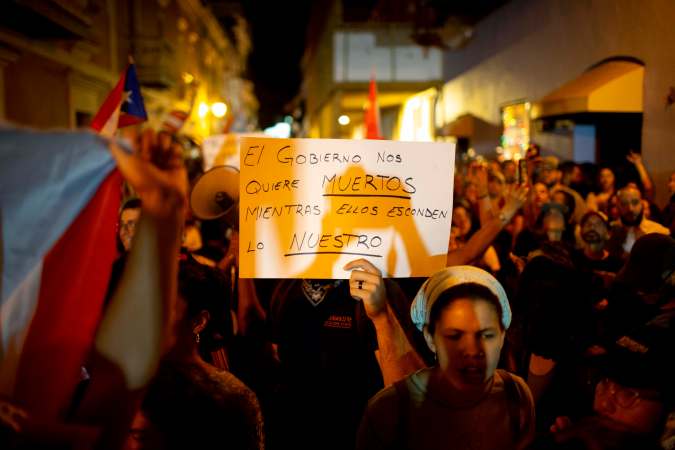
Vázquez initially affirmed she did not know about the warehouse in Ponce — or others like it, as reports of which are continually surfacing. But various political figures, including Puerto Rico’s Housing Secretary Fernando Gil Enseñat — who was fired by Vazquez after the scandal — along with Emergency Management Director Carlos Acevedo, say she knew about the unused aid. Her signature also appears on documents acknowledging the existence of several warehouses, including the one in Ponce. On Thursday, she admitted in a press conference that “everyone knew” about the warehouses.
“It’s really important that they hear us again.”
There is a steadfast faction of Puerto Ricans that does not support the protests. That group includes Rey Charlie, a social media personality and leader in last summer’s protests, who recently posted a video saying he wouldn’t join these actions and that everyone should wait until November to vote in local elections.
Activists protesting now, though, say they can’t wait. “Burn your electoral card,” reads another spray-painted message on walls of Old San Juan.
“They need this [protest] for a wake-up call,” William, a 24-year-old who works in Arecibo and asked that his last name be withheld, tells Remezcla about the government. “[They have] to get the f**k out of here.”
Like last summer’s weeks-long movement at La Fortaleza, the call to show up in Old San Juan is ongoing. Protests will likely continue through the weekend.
Additionally, on Wednesday, activists expulsed two political figures — Ricardo Llerandi, former director of the Puerto Rico Trade and Export Company and once chief of staff under the Rosselló administration (he resigned in the wake of Telegramgate), and Sen. Miguel Romero — from a San Juan coffee shop. The protesters condemned the pair for corruption and their roles in loss of life post-María, calling them assassins.
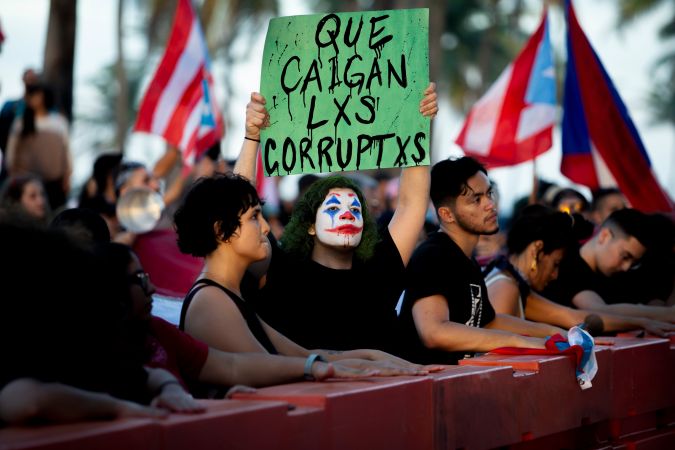
Protests have also been organized around the archipelago, including on Monday in the outlying island of Vieques, where a 13-year-old girl recently died, allegedly due to a lack of medical care since the local hospital hasn’t been rebuilt since it was destroyed by the 2017 hurricanes. Funds were approved by FEMA on Tuesday to build one.
Yamille Rodriguez, who on Monday had traveled to Old San Juan from the western municipality of Arecibo where he studies at the University of Puerto Rico, wore a rainbow flag like a cape as he stood near a wall that read “Gobierno Asesino.” His main impetus for making the drive: “We’re still dealing with the same lies,” he tells Remezcla. The 23-year-old expressed complete distrust in the Puerto Rican government, saying he wasn’t surprised by the discovery of the “secret warehouses” but was astonished by the government’s continued mistreatment of the people.
“The system collapsed a while ago.”
“They saw that we were able to take out Ricky,” Rodriguez says. “They saw that we’re engaged, and they still lie to us. It’s really important that they hear us again.”
On Google Maps, Old San Juan’s Calle Fortaleza is doubly labeled. During the summer protests that resulted in the August 2 resignation of former Gov. Rosselló, activists renamed it Calle de la Resistencia. Earlier this week, the actual tile bearing the street name was altered — again — to bear its protest assignation.
Wearing a “Calle Resistencia” T-shirt on Monday night, Nitzayra Leonor stood outside the Capitol, along with hundreds of others who would soon march back to La Fortaleza, where the first demonstration began.
“I feel like the system collapsed a while ago,” the 22-year-old says. “And we keep acting like the system hasn’t collapsed.”
